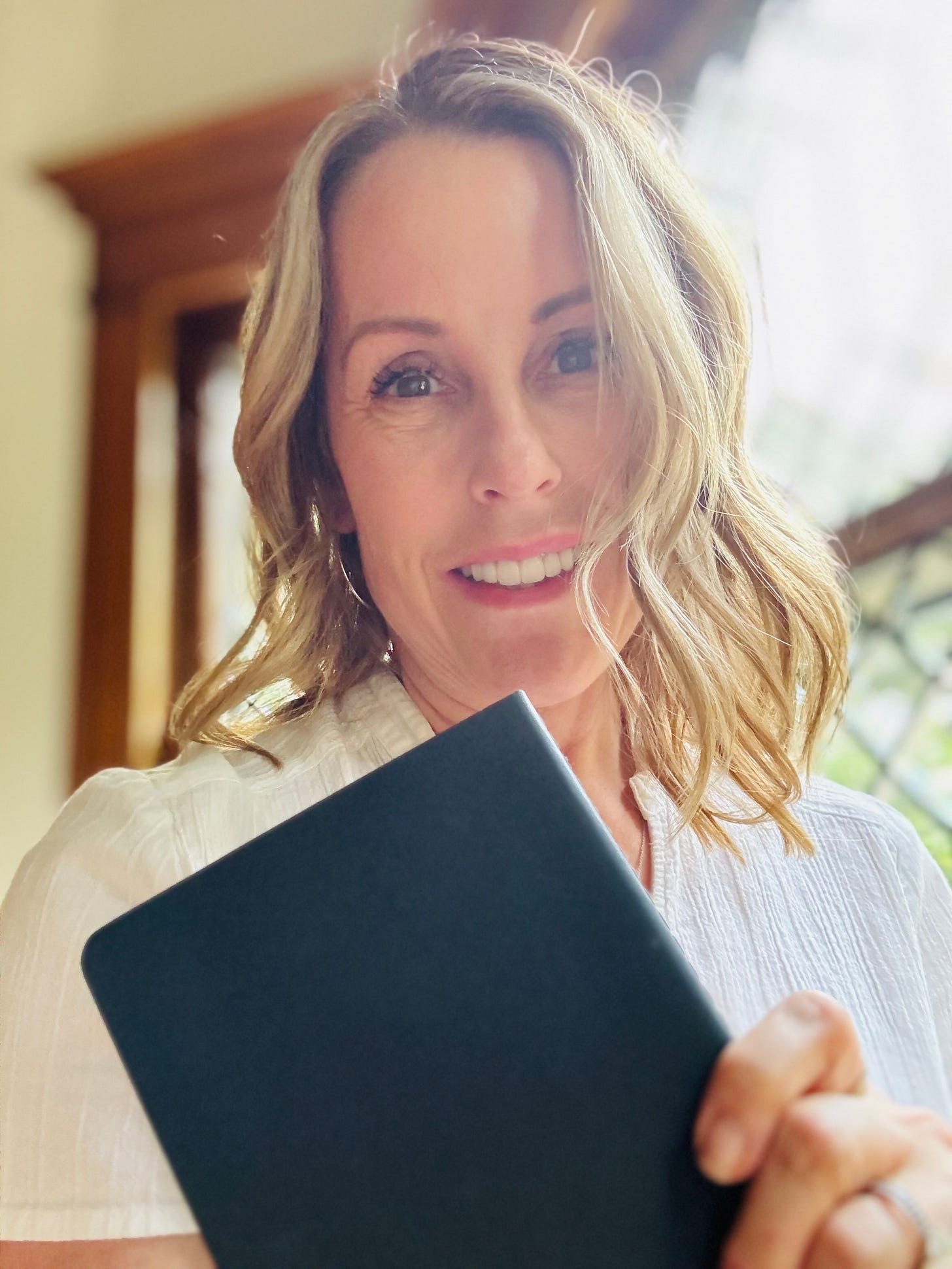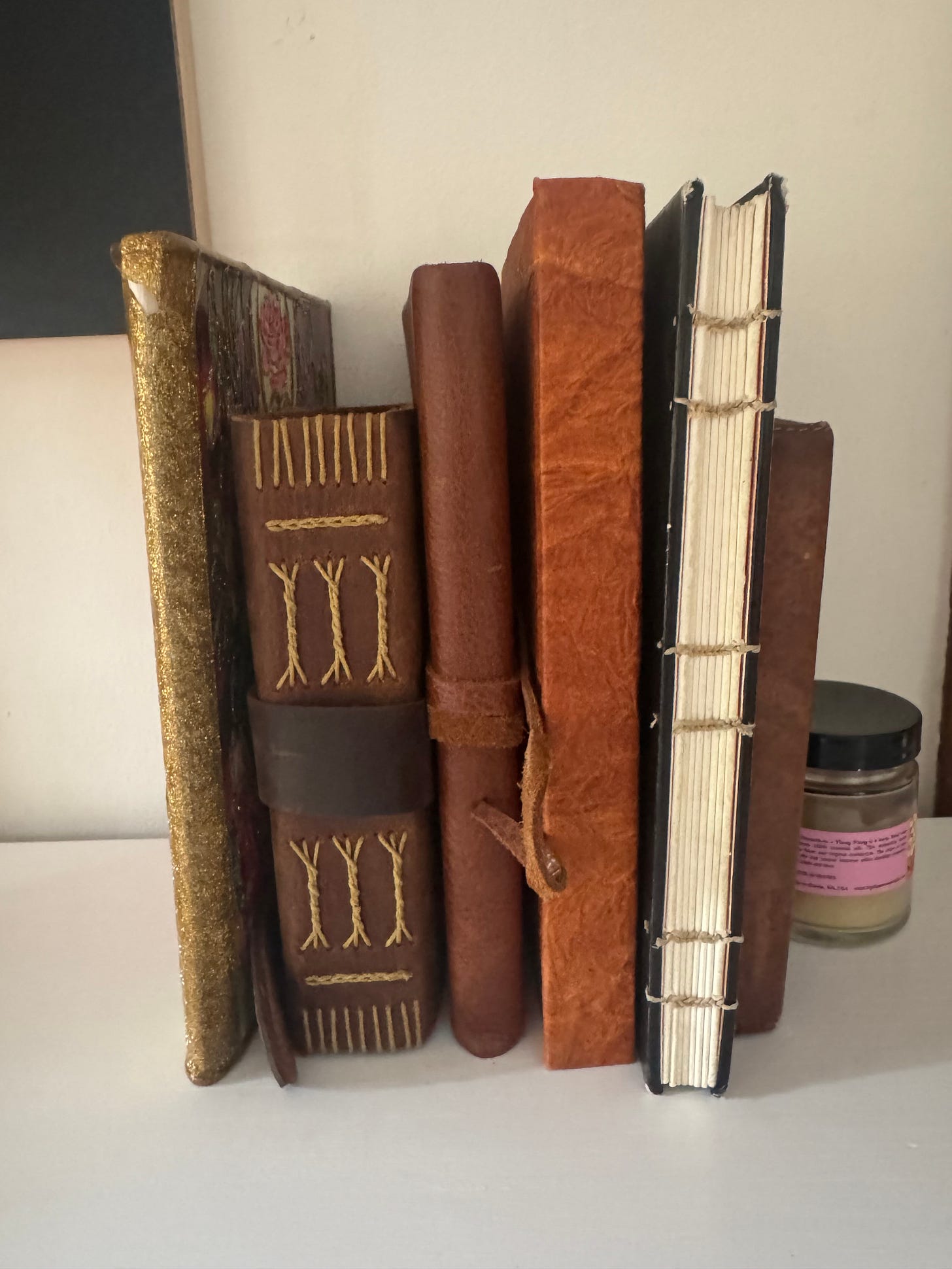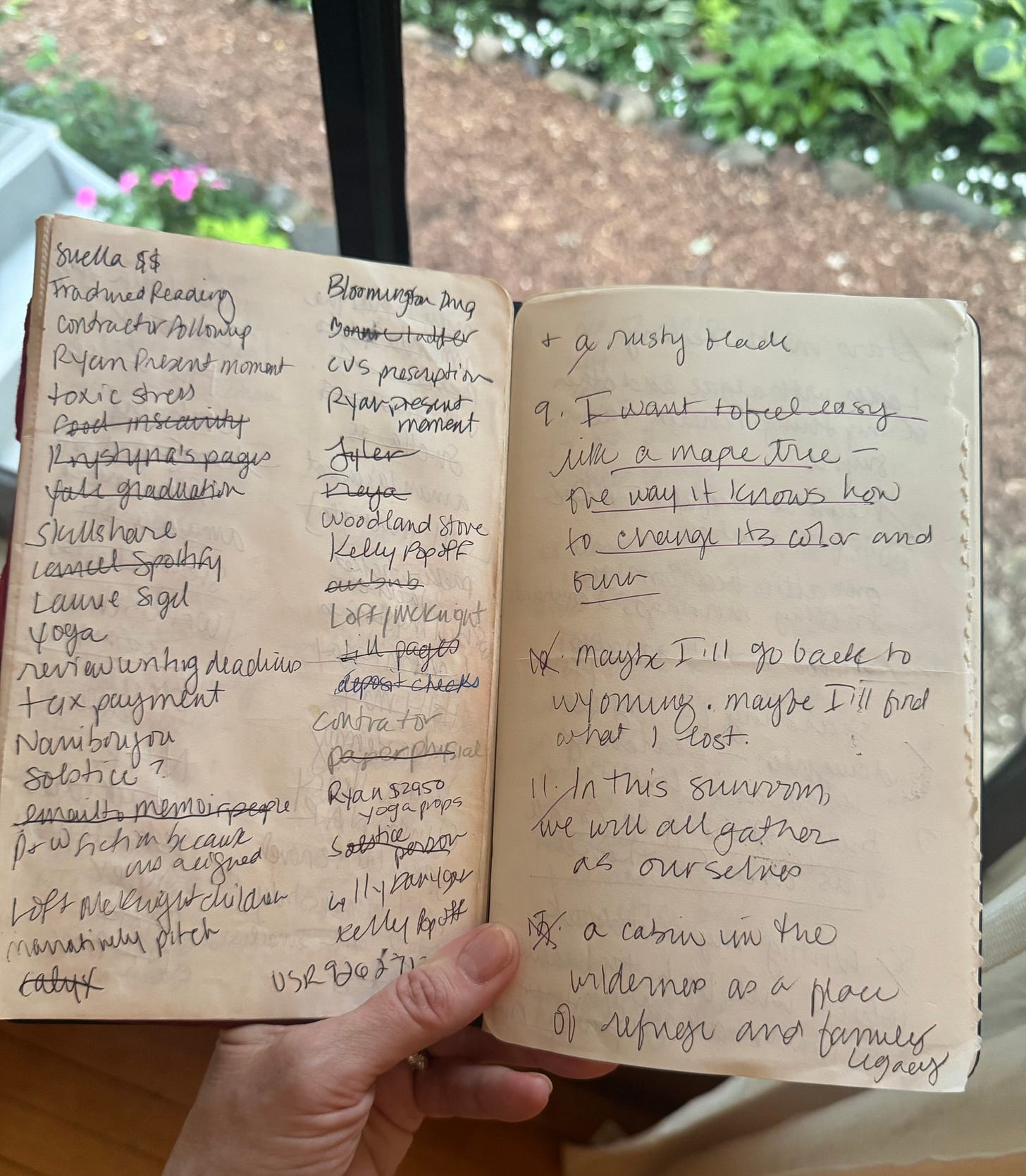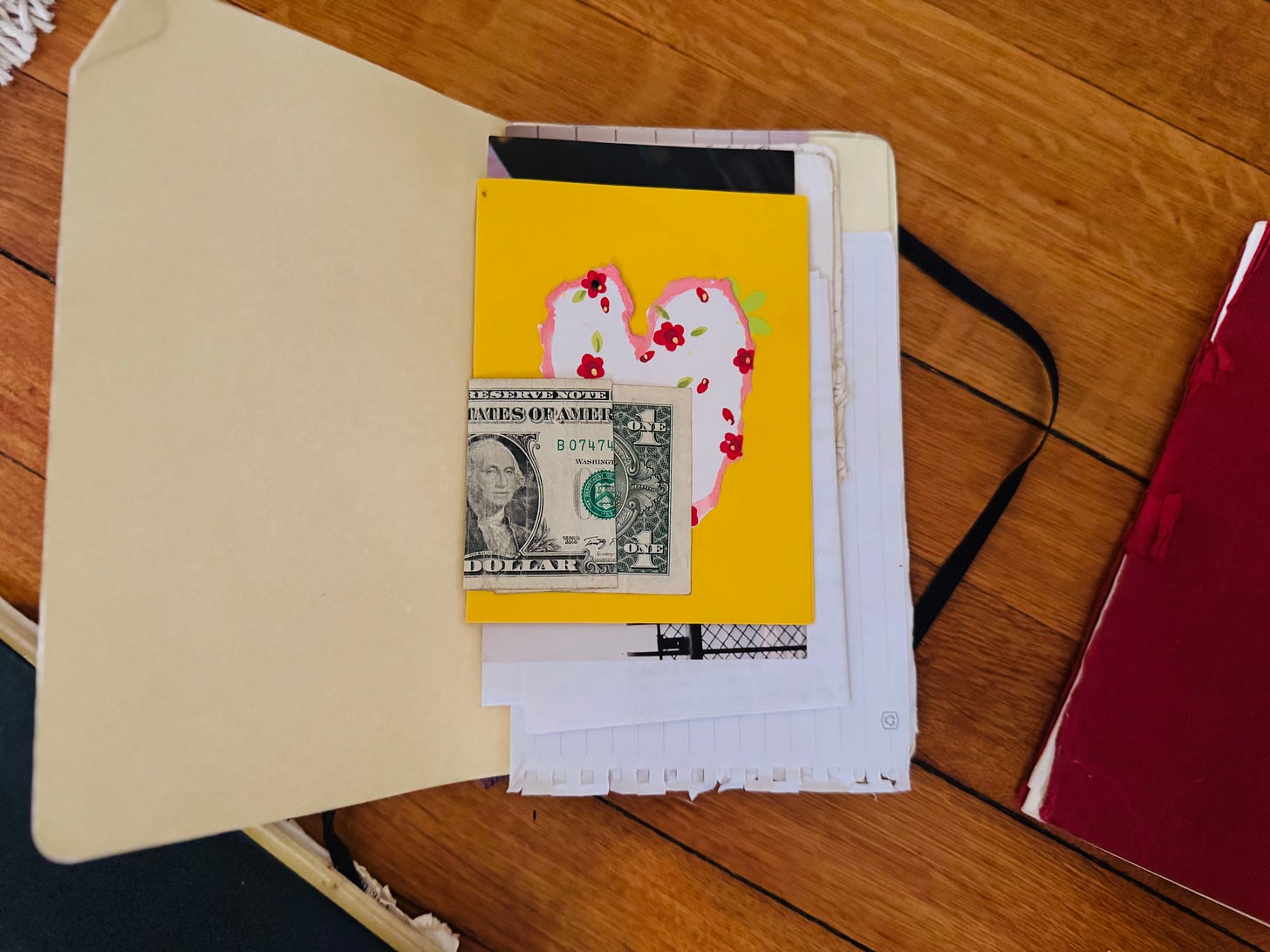SHOW ME YOUR DIARY
featuring writer and community-builder Jeannine Ouellette
Hello there! Welcome to The Magpie, a newsletter that serves as a collection of shiny objects about writing, creativity, hopes, and obsessions. My current obsession is diaries and the people who write them. Since I started keeping one at age eight, my diary has been a place of exploration and intensity, of lists and favorite quotes, of ticket stubs and wildflowers. It is a place to remember and a place to dream.
My most recent book, The Leaving Season: A Memoir in Essays, is out now! I relied on decades of my own diaries to help me write this book. My next book focuses on historical diaries of women, famous and not, and why we continue to write—and read!—these archives.
This is a Show Me Your Diary interview, a series that explores diaries and the creatives who keep them. Every week, I ask a new person to give us a peek inside their diary process, complete with photos. Yes, we are very nosy!
Want to show me your diary, or know somebody who does? Send me an email—you can just reply to this newsletter. Let’s get started…
Today’s interview is with Jeannine Ouellette, taboo-smashing writer, powerhouse teacher, and whipsmart writing coach. Her substack, Writing in the Dark, is a masterclass in community building and supported writing.
I first met Jeannine in our shared hotel lobby during AWP years ago, though I was familiar with her work, of course, especially her book, The Part That Burns, a gorgeous memoir about the legacy of family trauma. Her essay, “The Cost,” is one of the most haunting pieces of writing I have ever read. Her work has made me rethink everything I thought I knew about silence and I was grateful to have her guiding the way when I was working on my own memoir. Just seeing her out in the world, shining like a lighthouse off in the distance, helped me keep going.
I knew she kept a journal from her work, but I had no idea the beauty and enthusiasm that would explode forth from our interview! Not to mention the beauty of her journals themselves. Jeannine has written about The Outsized Power of a Childhood Narrator and it was such a delight to see her own childhood narrator in her journal pages, hard at work developing a relationship to her self and the world, developing her power of narrative.
In a Lifetime Achievement Award speech reprinted by LitHub last year, Dorothy Allison asked, “What if life really was a story? What if you could alter the plot? Assign meaning to the most brutal contempt?” She spoke of crafting and reclaiming narrative—especially the narrative of traumatic childhood—as survival. I believe this is what many women do on a daily basis in their journals, whether they are published writers or not. I am so grateful to Jeannine for sharing how she did this as a child, and how she continues doing this as a writer, and how the two impulses inform each other.
For this interview, we talked about the pressure of the word diary, the meaning of the word Abracadabra, and the delight of being a slob in your own journal (showing up “in the equivalent of a T-shirt and underwear” on the page). For the first time in this series, we also talk about lying in our journals. (Spoiler alert: we both do this.)
And, as always in Show Me Your Diary, Jeannine gives us a peek inside some of her actual diaries…welcome!
THE MAGPIE: Team Diary vs Team Journal? What do you like to call it?
JEANNINE OUELLETTE: Journal, for sure! To me, diary means a record of each day, or something like that, which I know doesn’t have to be true, but it’s how I’ve always thought of it and that’s hard to shake. A journal, on the other hand, feels more flexible. My journal can be stray thoughts, striking phrases or images I want to remember, lines of dialogue I overhear in public spaces, goals, inner questions, doodles and sketches, stickers, lyrics, to-do lists, reminders, and more. A journal of mine is often like a collage that only I understand. Actually, I sometimes don’t even understand pages of my journal later, when looking back at them, a fact I certainly encountered while paging through old journals for this interview!
One more thing about a journal, at least as I define a journal: I don’t ever have to feel guilty or down on myself if I don’t write in it every day. It’s just there for me as I am wanting and able. It’s a net, a basket, a bowl to catch the shimmers and shards of life.
I don’t ever have to feel guilty or down on myself if I don’t write in it every day. It’s just there for me as I am wanting and able.
How long have you kept a journal?
I started my first diary in second grade, and I still have it around here somewhere—I looked at it just a few months ago. But I wasn’t able to find it to photograph for this project, which is too bad, because it’s pretty cute. It as a little bear on the cover, which snaps shut with a little tab.
I did find one I thought I’d lost, though—it’s from sixth grade, and I was recording my poetry in it, including a poem I wrote in school, “The Hidden Center,” over which my teachers made a pretty big fuss. I took a photo, but the pencil is pretty faint, so I’ll type it out here, as well:
A young farm boy lay in the grass looking up
at the sky. There were so many things to see;
the spidery black branches of the trees against
the fiery orange sky, glowing with the light
of the setting sun. And in the distance he saw
the fields, bare except for a forlorn scarecrow
wavering back and forth in the wind. On the other
side he saw the barn, surrounded by bales of hay.
Then the whole scene was laced by graceful black birds.
And all of this scenery was centered around the boy,
though he was hidden by it all.
Yes, I was a very sad child. But my teachers’ reaction to that poem (despite what I now see as excessive adjectives!) was honestly the moment I knew—really knew—that I would become a writer.
But as for most of my childhood diaries, they tend to be mostly blank. Nonetheless, I’d ask for a new one for Christmas almost every year of elementary school, and if I got one, I would do the same thing again: write in it for a couple of weeks, or sometimes just a few days, and then abandon it. Diary after diary, I did that. So, you see why I had to switch to journals! Somehow, thinking of them as journals takes the pressure off, which is good.
But … even with less pressure, I have, through most of my adulthood, still tended to start journals and eventually leave them fallow with many blank pages left before starting a new one. This habit is evidenced by the massive number of old journals I have in my house, the ones shown here being only most but by no means all of my collection.
The way I solved this for good is that finally, a few years ago, I switched to super simple, small, soft-cover blank notebooks—always unlined—that double as a to-do list and a journal. These only have 60 pages and I always use them all!
What do you hope will happen to your journals once you are gone?
I’ve actually thought about this a lot. What I hope will happen is that my kids will sit around and page through them after whatever celebration they hold when I die. I’m pretty good about keeping all the journals together, so they’ll be easy to find.
I picture my kids laughing and crying and reminiscing about all the slivers of life they recognize, and all the ways in which they recognize me. They’ll find so many facets of our lives in those journals. They’ll find millions of lines of poetry—poetry that is often about them—plus notes about my dreams, meal planning ideas for family cabin weekends, pep talks to myself about my writing projects, sketches of our dog Frannie, funny little affirmations, love notes to people I’m thinking of, and, in addition to all that kind of thing, a lot of indecipherable bits and bobs about who knows what.
I’m pretty sure my kids will be interested in perusing my journals, not just because I’m their mom, and a writer, but because I passed the journaling habit down to them, too. My youngest, especially—their name is Billie—is an avid journal-keeper and their journals are so beautiful. Far, far, far more beautiful than mine. No comparison. Their journals are like graphic memoirs, really. These gorgeously illustrated scenes from their life narrated in the most lyric and fragmented way. I’m jealous of their journals, but I’m also full of admiration and awe. In fact, Billie, who is also a talented, published writer, is going to be teaching a workshop on graphic journaling, exploring this link between visual art and the written word (even for “non-artists”) at this summer’s Writing in the Dark | The CAMP at Camp Wandawega. I’m super excited about it because I’ve never co-taught writing with Billie, and we have a musician collaborating with us, too, so the richness of this multi-discipline approach to writing should feel super new, challenging, inspiring, and, hopefully, freeing.
But anyway, even though my own journals are utterly chaotic, untidy, strange and sometimes inscrutable, I hope my kids will page through them when I am gone and see a version of me they know and love, as well as discover new versions of me they’ll find surprising, affirming, and possibly even comforting. Hopefully not shocking, but I know that could happen, too.
Mostly, I hope they’ll feel me with them in some real way that we can’t yet fully understand. My kids and I have collaborated on a lot of artistic projects together, so maybe through my journals they will feel a sense of our shared creative process still operating all around them. Maybe they’ll feel my presence from wherever I am—still making poetry and art from my love for them.
Do you use a particular journaling software on your computer or just the Notes app on your phone?
I do jot things in my phone, both with the Notes app as well as by texting to myself, but I mostly use those paperback Moleskine-type journals I mentioned earlier.
I have many, many, many beautiful hardbacked or leatherbound or handmade-paper journals that I love but never use. So about 10 or 15 years ago, I switched to Moleskine journals—first the hardcover ones, then the softcover ones that feel kind of like paperback books in shape and heft—you know the ones with that elastic band to keep them closed.
The softcover Moleskines were pretty good, but these lighter, thinner, even softer paperback ones are my absolute favorite because they’re just not at all precious. For whatever reason, that makes me feel free. And even if I lose one (which is very rare, but it just happened in June!), I’m disappointed but not that disappointed, because they don’t have a ton of pages, so I haven’t lost that much.
These journals are very easy to tuck in my bag, and they also lie perfectly flat to write in which I love. The thing about these simple, inexpensive journals is that they aren’t trying to be anything special. They’re just paper. They’re so humble. I actually don’t even call them journals, I call them “my black notebook” and everyone in my family knows what I mean.
By the way, these are the same journals I mentioned earlier—the ones that double as my to-do list. What I do whenever I start a new one is this: I start the to-do list on the first page and start the journal at the centerfold. Then, when the book fills up, I start a new one.
I actually don’t even call them journals, I call them “my black notebook” and everyone in my family knows what I mean.
When do you write in your journal?
I write sporadically, just whenever I need to jot something down. Since the journal also serves as my running to-do list, I do usually write in it at least once a day. But that might be just a word or two about something I don’t want to forget. Longer things, reflections, goals, snippets of real writing, those I write more like a couple of times a week.
I don’t put any pressure on myself when it comes to journaling. It’s not something where I need to set any expectation of myself. I write so much now—especially with my Substack, Writing in the Dark, where I publish five times a week. Since Writing in the Dark is a community for writers where I both teach and share my own work, and where I am constantly thinking out loud and documenting scenes from my own life. I think knowing how much of my life I’m capturing on Writing in the Dark makes me feel even freer when it comes to journaling. My journals—these black notebooks/to-do lists where I also store my thoughts—are totally for me to write in whenever and however I want, with zero pressure.
Do you ever lie in your journal?
I lied a lot as a kid. Lied and lied and lied and lied. Lied through my teeth. My childhood diaries are composed almost entirely of lies.
I had a very traumatic and abusive childhood, but my diaries read like walks through the park on a summer’s day with butterflies circling my golden hair. Note: my hair was never golden. The lying continued through high school. I even have, in my memoir, The Part That Burns, a chapter from my ninth-grade journal showing the depth of the lies I told about myself and, more dangerously, the lies I told to myself. I created that project on loose-leaf notebook paper with photos taped in, and I’ve photographed a few pages for this interview.
But I don’t lie like that anymore! In fact, sometimes pages in my journal are so honest I have to destroy them. That was true of a certain fancy gold-beaded journal—there’s a photo of this one!—that I started writing in early in my current marriage. In one case, I was writing about my husband during the middle of a bad fight. I said terrible, cruel things I didn’t mean, angry things that felt good to vent, but that were way over the top compared to what I actually believed.
Later on, whenever I looked at that journal—which stood out because of that gold-beaded cover—I would think of how awful it would be if anyone read those pages. Not just my husband, but anyone. So eventually, I did destroy those pages. Years after that, I found out that my husband had actually read them already, and never told me, which made me really sad. And no, I did not feel violated that he read my journal, because I don’t call my journals journals or treat them as particularly private. I call them my notebooks and leave them lying around. So I don’t think he thought he was being invasive when he opened it. I still wish I could take back those pages and it was a good lesson in regard to what to write down and what should maybe be screamed into the air where it can make a big noise and even an echo, and then dissipate as it is meant to.
Do you ever tuck ephemera into your diary (ticket stubs, flowers, stickers, etc)?
Yes! I stick tons of things in my journals. Cards and letters, photos, scraps, drawings, checks I’ve deposited digitally, and sometimes for some reason I even find money in them. When I started opening old journals for this project, all sorts of things started falling out.
But I put the ephemera back because I kind of like the idea of things hiding in the journals, you know? Like little treasures tucked away. There’s something nice about it.
I put the ephemera back because I kind of like the idea of things hiding in the journals, you know? Like little treasures tucked away.
Do you ever re-read your old diaries?
Yes! I love to look back on old journals. Recently I found one from about twelve years ago, where I was working through Danielle LaPorte’s Fire Starter series, and it was so fascinating. That series is all about your core desires, and what you’re trying to move toward in your life.
What surprised me is that I was completely accurate about what I really wanted. It was uncanny! And almost all of it has come true—my memoir, my teaching work, my retreats for writers. I had totally forgotten that I wrote all that stuff down. Writing things down really is magical. Abracadabra means As I speak, I create—and with writing, it is even more so.
As a writer, how is your voice different in your journal than on the page?
I love this question, because it’s complicated and feels directly related to the question of how we develop a writing voice. I definitely feel some difference between my voice in my journals compared to my voice on the page, if only because in my journal I can just be totally free and allow things to be incomplete and even incoherent if I want. My journals are very messy!
But, at the same time, my “regular” voice and my writing voice have come very close together in recent years, with significant overlap. I think that’s because I have been writing as a writer for so long, and I write so prolifically as a writer now because of Writing in the Dark.
But, of course, my writing voice takes on different tones and registers depending on the project, and therefore will always demand far more of my attention in terms of cultivating and shaping it than my regular voice for speaking and journaling. That regular voice, I don’t cultivate at all. I let it be whatever it wants to be, and a lot of the time, it wants to be at least a little literary. Sometimes it just wants to be a slob, which we know can also be literary. But when it wants to make a grocery list, I think it’s just a worker doing work, and I’m happy to let it be that. If my journaling voice wants to do the metaphorical equivalent of sitting around in a T-shirt and underwear with mascara under its eyes, I let it. After all, that’s pretty much how I look when I’m writing.
That regular voice, I don’t cultivate at all. I let it be whatever it wants to be, and a lot of the time, it wants to be at least a little literary. Sometimes it just wants to be a slob, which we know can also be literary.
More About Jeannine Ouellette:
Jeannine’s bestselling Substack, Writing in the Dark, is a passionate creative community for people who “do language,” where writing is part of a deeper, vaster conversation about how attention, curiosity, playfulness, and surprise provide a portal to the profound, because talking about “how to write better” without that larger context is kind of boring. Her short literary work has appeared widely in journals and anthologies, and her lyric memoir, The Part That Burns, was a 2021 Kirkus Best Indie Book and a finalist for the Next Generation Indie Book Award in Women’s Literature. She teaches writing at the Minnesota Prison Writing Workshop and the University of Minnesota and, of course, through Writing in the Dark.
Read Jeannine’s Work:
Upcoming Workshops with Jeannine:
Writing in the Dark | The CAMP in person at Camp Wandawega, August 18-22
Find Jeannine online:
Find
on Substack at Writing in the Dark
Thanks for reading The Magpie by Kelly McMasters! As always, more of what I’m up to can be found on my website, and you can follow me on Instagram for day-to-day updates.
Buy The Leaving Season here, Welcome to Shirley here, Wanting: Women Writing About Desire here, and This is the Place: Women Writing About Home here.


















I loved this edition of Show Me Your Diary so, so much but that doesn't surprise me at all as I adore Jeannine and have been a devoted student of hers at Writing in the Dark since 2023. It was fun to get this peek at Jeannine's journaling and diary-keeping from childhood to now. As a lifelong journaler, it's so fun to see these photos of journals and what's inside, the ways in which writers use their journals, and I appreciated the unaffected, relaxed, whimsical, a little messy, always interesting approach of Jeannines journals, mixing the daily to-do lists and shopping lists with drawings and doodles as well as the "shimmers and shards" of observations (she'll know what I mean:-) that a writer is always looking for. In essence, these journals signaled "play" to me which is what Jeannine and Writing in the Dark is all about. My take-away is to perhaps step away from my lined journaling notebooks, grab an unlined humble Moleskine and colored markers and see what happens.
I love this!